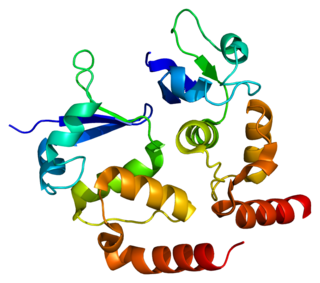
Potassium voltage-gated channel subfamily D member 2 is a protein that in humans is encoded by the KCND2 gene. It contributes to the cardiac transient outward potassium current (Ito1), the main contributing current to the repolarizing phase 1 of the cardiac action potential.

Potassium voltage-gated channel subfamily D member 3 also known as Kv4.3 is a protein that in humans is encoded by the KCND3 gene. It contributes to the cardiac transient outward potassium current (Ito1), the main contributing current to the repolarizing phase 1 of the cardiac action potential.

Voltage-gated potassium channel subunit beta-1 is a protein that in humans is encoded by the KCNAB1 gene.

Potassium voltage-gated channel subfamily KQT member 5 is a protein that in humans is encoded by the KCNQ5 gene.

Potassium voltage-gated channel, Shaw-related subfamily, member 4 (KCNC4), also known as Kv3.4, is a human gene.

Potassium voltage-gated channel, subfamily H (eag-related), member 5, also known as KCNH5, is a human gene encoding the Kv10.2 protein.

Potassium voltage-gated channel, Shal-related subfamily, member 1 (KCND1), also known as Kv4.1, is a human gene.

Kv channel-interacting protein 4 is a protein that in humans is encoded by the KCNIP4 gene.

Potassium voltage-gated channel subfamily C member 1 is a protein that in humans is encoded by the KCNC1 gene.

Potassium voltage-gated channel subfamily A member 6 also known as Kv1.6 is a protein that in humans is encoded by the KCNA6 gene. The protein encoded by this gene is a voltage-gated potassium channel subunit.

Potassium voltage-gated channel subfamily A member 10 also known as Kv1.8 is a protein that in humans is encoded by the KCNA10 gene. The protein encoded by this gene is a voltage-gated potassium channel subunit.

Potassium voltage-gated channel subfamily F member 1 is a protein that in humans is encoded by the KCNF1 gene. The protein encoded by this gene is a voltage-gated potassium channel subunit.

Potassium voltage-gated channel subfamily G member 3 is a protein that in humans is encoded by the KCNG3 gene. The protein encoded by this gene is a voltage-gated potassium channel subunit.

Potassium voltage-gated channel subfamily G member 4 is a protein that in humans is encoded by the KCNG4 gene. The protein encoded by this gene is a voltage-gated potassium channel subunit.

Potassium voltage-gated channel subfamily V member 1 is a protein that in humans is encoded by the KCNV1 gene. The protein encoded by this gene is a voltage-gated potassium channel subunit.

Potassium voltage-gated channel subfamily V member 2 is a protein that in humans is encoded by the KCNV2 gene. The protein encoded by this gene is a voltage-gated potassium channel subunit.

Potassium voltage-gated channel subfamily S member 1 is a protein that in humans is encoded by the KCNS1 gene. The protein encoded by this gene is a voltage-gated potassium channel subunit.

Potassium voltage-gated channel subfamily S member 2 is a protein that in humans is encoded by the KCNS2 gene. The protein encoded by this gene is a voltage-gated potassium channel subunit.

Potassium voltage-gated channel subfamily H member 6 is a protein that in humans is encoded by the KCNH6 gene. The protein encoded by this gene is a voltage-gated potassium channel subunit.

Potassium voltage-gated channel subfamily H member 8 is a protein that in humans is encoded by the KCNH8 gene. The protein encoded by this gene is a voltage-gated potassium channel subunit.





















